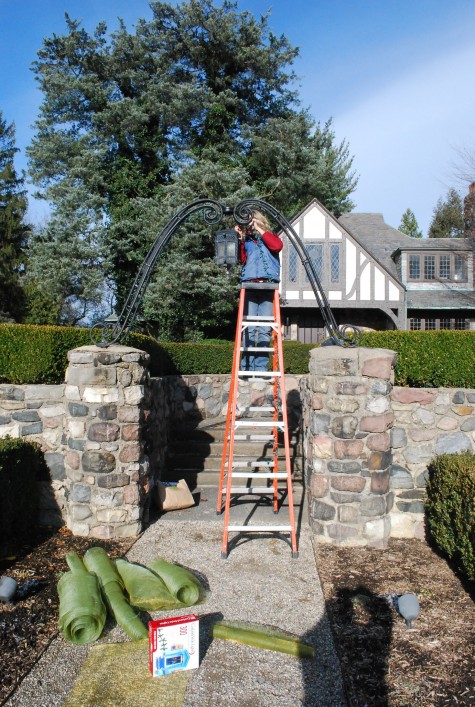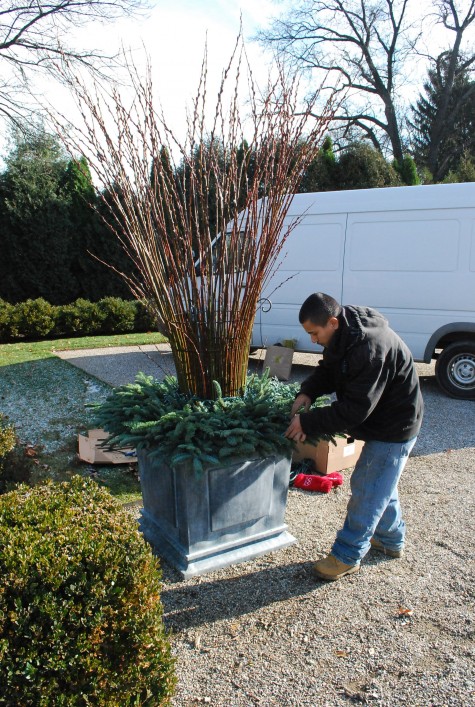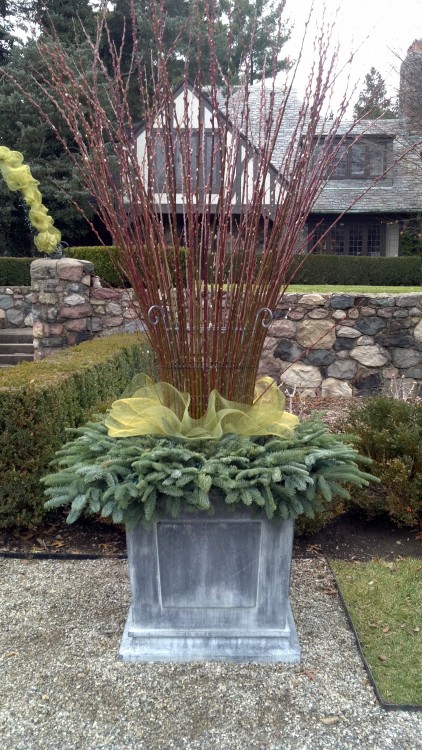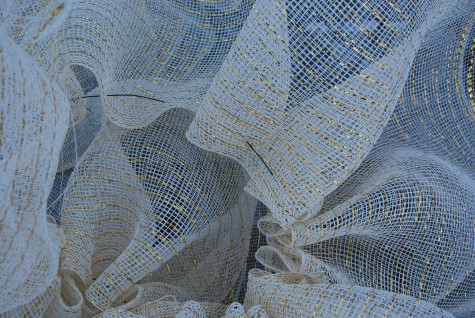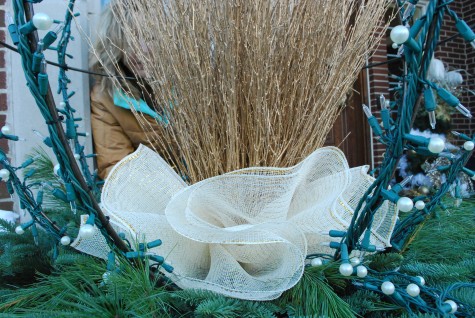Ruching the sinamay-what does this mean? An explanation is to follow. I am convinced that there are those select and gifted people who can make beautiful bows, swags, and riffs, graceful gestures with fabric and ribbon, and then there is the rest of us who are all thumbs. As I know I belong to the all thumbs group, I am interested in materials that make me look good. Sinamay-do you know this material? I did not either, until a few years ago. Sinamay is a fabric made from the acaba tree. It produces a wiry thread that makes for great woven hats that filter the sun, and great ribbon that has lots of natural body. Natural sinamay is usually bleached and left that natural cream color, or dyed a color.
The faux sinamay I use is made from very springy polyester fibers. I may be making this up. Faux sinamay may be plastic fibers, that are woven. I buy this by the roll, for the holiday and winter season. Holiday sinamay is an open weave fabric, some 18 inches wide, sometimes shot through with gold fibers. This material is impervious to any winter weather. The best gesture available from the sinamay-volume. Lots of volume without a lot of effort. Even after a drenching rain, or an entire winter season, this material is as poufy as it is day you put it up.
This client has an iron arch over her staircase to the front door. We wired that arch with 2 strings of garland lights. Once the lights were up, Pam would attach green sinamay over top. We cut lengths from the roll that were 4 times longer than the length of each section of iron. Pam attached the sinamay at each end, and then bunched the fabric and zip tied from the center to each end. This is a laborious explanation of what is simply called ruching. Ruching fabric is a method of evenly gathering a length of fabric to create ruffles.
These stone pillars are robust and hefty. The sinamay will provide a lot of volume to the arch, which is much more delicate in scale. This will help to bring the arch into a scale better suited to the size of the pillars. I could not sew a ruffle on a garment if my life depended on it, but I can bunch and zip tie. We order the narrowest zip ties available, in a medium or long length. This size passed through the open weave of the sinamay easily. On a very cold day, even nimble fingers slow down and miss. How this fabric presents reveals nary a miss. Curly, energetic and sparkly-what could be better for the holidays?
Ease of installation is really important for outdoor projects. It was barely above freezing the day we installed this project. The greens and willow stems in the pot were constucted in the garage. It isn’t exactly a warm space, but it is warm enough to work without gloves. After setting both the top and bottom in the pot securely, all that was left to do was to hide the light cords.
Holiday lighting comes with the most glaringly artificial green wires. It is not an issue at night, but during the day, I cannot stand looking at those wires. Garland light strands are short-17 feet. There is less in the way of cords to hide. We tuck those wires back into the greens, and pull the light bulbs forward. All you see here during the day are the greens. The sinamay is both springy and soft in appearance. At night, the lights will reflect off the gold threads. This adds a little night time sparkle. This box has a holiday tutu-I like the entire idea that a solid and seriously square zinc box has a holiday outfit.
It was quite a few years ago that I designed and installed the landscape here. The full drivecourt is actually 60 by 60 feet. A holiday display in a space this large needs to have a lot of volume. The willow tied over the topiary forms makes a substantial statement in the zinc boxes. The sinamay is cloudlike, frothy. In the dark that is the winter, the iron arch would be all but invisible. The sinamay makes a feature of it.
Ruching sinamay is very simple. I fold the sinamay in half width wise, so my ruffles are about 9″ long. They I pierce the fabric in and out-as in a running stitch- with 22 gauge paddle wire. Paddle comes wound on a flat spool, and is very strong. Though I may use florist’s wire that comes cut to length for attaching materials to a wreath, some projects call for a long run of wire. Think of the paddle wire as a beefy thread.
The wire runs right along the fold in the fabric. For these pots, I probably used 10′ of the sinamay, and bunched it up on 2′ of wire. If your in and out stitches are fairly uniform, your ruching will be uniform. I do not measure the stitch length-I just do the best I can, by eye.
These pots have a centerpiece of gold twigs. The wire is would around the base of the twigs, pulled very tight, and twisted enough times to make sure the ruffle will not come loose. Then we move around and arrange the ruffles so they look graceful. It is very obligingly ruffly, even if your skills with fabric are not the best. The key to a good result-use more than enough, and then some.

Once the ruching was finished, we added some off white berry stems. The topiary forms are wound round with lights; the centerpieces will shine at night. Even from this distance, the ruched sinamay provides a soft and curvy transition between the vertical centerpiece, and the horizontally composed greens. That this very graceful material is so easy to use and so predictably good looking, makes it a staple material in my holiday decorating.



